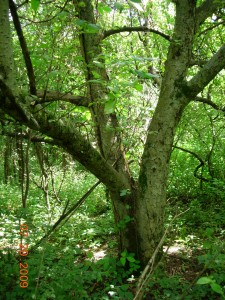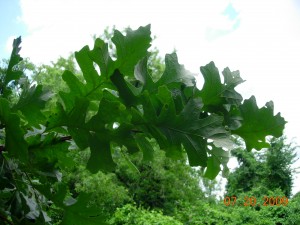The following is approximately what I said in my brief remarks at the Save the Colony Farm Orchard Rally last Tuesday night, 8 December 2009. I have, however, expanded on my thoughts under point 3, adding a consideration of conservation easements.
We need to recognize three aspects to the conservation value of this piece of land. One is what’s good about the land itself. Two is its beneficial effects on the adjacent Asylum Lake Preserve, which Western Michigan says is permanently protected. Three is the broad question of how the conversion of this dedicated conservation land to commercial use affects the status of conservation land all across the state.

Apple tree in old orchard at the Colony Farm Orchard. Photo by Richard Brewer
1. The Land Itself. Although this land has been referred to as the Colony Farm Orchard, the old orchard amounts to only a quarter or so of the approximately 53 acres. The fruit trees are surrounded and in some cases overrun by grape vines. Box-elder is a common invading tree in the orchard.
The rest of the property is varied habitat with a couple of sizable wooded areas at the north and south ends. Grasslands dominated by smooth brome grass and goldenrods with invading shrubs and trees surround the wooded areas and the orchard. The land of the wooded area at the north runs down to a springy area with a couple of ponds.
One part of the conservation value of this piece of land is what used to be here. The east edge of Genesee Prairie, one of the eight tall-grass prairies in Kalamazoo County, extended to the Orchard site. This is now the only part of Genesee Prairie in public hands and with any approach to natural vegetation. The rest is gone, beneath US-131 or occupied by the west edge of Western Michigan University’s BTR park and commercial and residential areas and croplands west of US-131.
It’s unlikely that much of the original prairie flora is left at the Orchard site. However, there are still bur oaks–a good many, some fairly large and old, others young. They are all almost certainly descendants of the bur oaks that were part of the savanna fringing this tall-grass prairie. They are a genetic connection extending back 180 years to when the first settlers arrived to homestead on the prairies and savannas of Kalamazoo County. But the connection extends back much further than that, to long before Europeans reached Michigan or North America, probably to some time in the Hypsithermal interval around 9000-6000 years ago.

Goldenrods, old orchard in background. Photo by Richard Brewer.
As for animals, we know from various sources that there are coyotes, deer, turkeys, woodcock, Red-tailed Hawks, Green Herons, and many smaller birds in the summer or year-round. I will shortly put up a list of summer bird species that several observers are supplying. The spot also has all the attributes of an excellent migratory stopover site for land birds in both spring and fall. As to the small mammals, reptiles, amphibians, insects, I think it may be time for WMU to fund a serious study to find out just what is here.
2. Benefits to Asylum Lake Preserve. The Colony Farm Orchard is properly part of Asylum Lake Preserve. From the edge of the Preserve vegetation to the edge of the Orchard vegetation is about the same distance as between third base and home plate on a baseball field. The Orchard makes the preserve a larger sanctuary by about 20 percent. This is good; bigger is better in sanctuaries, mainly because local extinction of species is rarer on bigger sanctuaries.
We could also think of the Orchard as an island near to the Preserve. It serves as a stepping stone that wandering animals not currently living on the Preserve can find and, from there, reach the sanctuary. The end result of all this is that the Orchard makes the Asylum Lake Preserve more diverse and less prone to fluctuations in populations, hence more stable.

Bur oak at Colony Farm Orchard. Photo by Richard Brewer
There are of course the other beneficial effects of buffering against the noise, noxious fumes, and bright artificial lights coming from US-131 and the commercial land beyond it.
3. Threats to Conservation Land Elsewhere in Michigan. The Colony Farm Orchard has a protective conservation covenant that many Kalamazoo residents now know by heart: “The conveyance shall provide that Western Michigan University may utilize the property solely for public park, recreation, or open space purposes, except that the legislature, by statute, may authorize Western Michigan University to utilize the property for some other public purpose.” The restrictions were placed on the land by the legislature at the time of its transfer from the state to WMU in 1977. If Representative Jones (D-Kalamazoo) and WMU can persuade the legislature to strip away this restriction, as HB 5207 provides, and if Governor Granholm signs it, WMU will be able to use the land for anything. This land, bought with taxpayer dollars and now designated for public use–specifically some variety of public open space–would be available to use as an Annex to WMU’s BTR park. But it could also be used any other way WMU chose.
If HB 5207 is passed and signed into law, what state or university land dedicated for conservation–or any kind of public use–is safe? What of the state parks? What of the arboretums, botanical gardens, and natural areas of the rest of the Michigan public universities?
What, in fact, of conservation easements? These are now the most popular way to protect land in perpetuity, widely used by land trusts and government agencies. They are discussed in many places in Conservancy: The Land Trust Movement in America but especially chapters 7 and 8. Very briefly, a conservation easement is a binding agreement that permanently restricts the development and future use of land so as to protect its conservation values. Conservation easements are held by conservation organizations or units of local, state, or federal government. The easement holders are charged with defending against violations of the easement provisions. As of 2005, land trusts in Michigan held conservation easements on about 55,000 acres. The amount of land in conservation easements held by government agencies is hard to determine but substantial. Conservation easements are a relatively new way to conserve land, rarely used before 1960. Most states have statutes providing the legal foundation for conservation easements; Michigan’s is Act 451 of 1954, called NREPA.
But we have seen what the state legislature, or the House at least, has done with statutes in the case of the Colony Farm Orchard. Suppose some well-connected land owner found that a conservation easement held by some land trust had become inconvenient to him. Might the Michigan legislature be willing to pass a statute saying the conservation easement on his land was rescinded? Maybe, maybe not. Suppose that this situation came up two or three times. Might the Michigan legislature decide that NREPA as currently written was becoming an unnecessary burden to worthy land owners who had changed their minds about the easements on their acreages. In that case, might the Michigan legislature amend the statute to make backing out easier–like, for example, by coming to the legislature with what seemed like a good argument, such as using the land to create jobs? Maybe, maybe not.
The land owners might still have a few hurdles remaining, with the IRS for example. But that’s what attorneys and accountants are for.
If the legislature did either of these things, a judge or two or more would decide whether what the legislature did was legally OK. Probably the judges wouldn’t say whether it was right or wrong or how much it damaged the cause of land conservation.
It is a dangerous path that Representative Jones and WMU are trying to steer the Michigan legislature towards.
Pingback: Michigan League of Conservation Voters: Rep. Robert Jones-100, Colony Farm Orchard-0 | Richard Brewer